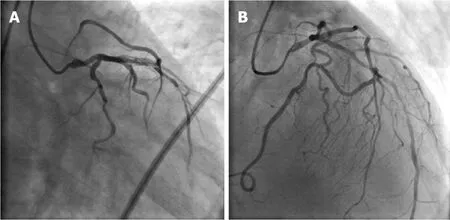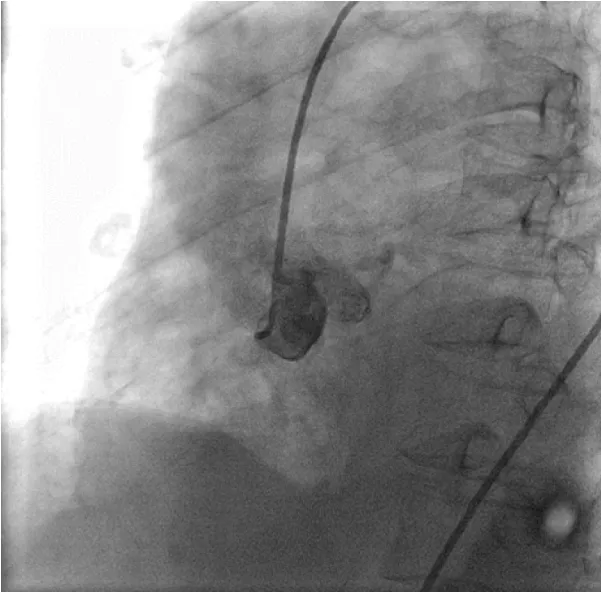Percutaneous coronary intervention for ostial lesions of the left main stem in a patient with congenital single left coronary artery: A case report
2019-08-14QiangWuZongZhuangLiFengYueFangWeiChenYunZhang
Qiang Wu,Zong-Zhuang Li,Feng Yue,Fang Wei,Chen-Yun Zhang
Abstract
Key words: Coronary anomaly; Single coronary artery; Left main coronary artery;Percutaneous coronary intervention; Case report
INTRODUCTION
Single coronary artery (SCA) that originates from a single ostium in the aortic trunk and perfuses the entire myocardium is an extremely rare congenital anomaly of the coronary artery.The incidence of SCA ranges from 0.016% to 0.066% in the patient population undergoing coronary angiography[1-3].Myocardial perfusion could be affected in patients with different SCA subtypes,such as SCA arising ectopically from the right aortic sinus and passing between the aorta and pulmonary artery before dividing into the left anterior descending artery (LAD) and left circumflex artery,slitlike ostium due to an acute angle of SCA,or those complicated with proximal atherosclerotic stenosis[4-6].Coronary artery ostioplasty and bypass grafting are recommended as the first-line revascularization therapeutic strategy for these subtypes of SCA which can cause serious,even fatal,consequences[7,8].In this case report,a patient with SCA,combined with severe ostial lesions of the left main coronary artery (LM) and significant stenosis of the left anterior descending artery(LAD),was successfully treated by percutaneous coronary intervention (PCI).
CASE PRESENTATION
Chief complaints
A 76-year-old woman with a medical history of hypertension and hypercholesterolemia was admitted with progressive angina over five months.
Examinations of the patient
Electrocardiography showed non-specific ST-T abnormalities.The transthoracic echocardiography findings were normal for left ventricular performance without segmental hypokinesis.Diagnostic coronary angiography performedviathe transfemoral approach showed that the LM,which normally originates from the left sinus of the Valsalva,had a 95% ostial calcified stenosis and slight shaft lesion.The LM branched into the normal left circumflex artery and the LAD with a diffuse lesion(70%-99%) in its mid segment with delayed distal flow.An anomalous branch without significant lesions arose from the mid-portion of the LAD and perfused the notional area of the right coronary artery (RCA) (Figure 1).The LAD wrapped around the apex,had an extended length,and then supplied to the posterior and inferior wall.Aortography revealed a blunt right and noncoronary sinus without any stumps(Figure 2).
FINAL DIAGNOSIS
The patient was diagnosed with coronary atherosclerotic heart disease with unstable angina; essential hypertension and hypercholesterolemia; and congenital SCA anomaly with branching of the RCA originating from the LAD,complicated with ostial LM lesions and a mid-segment stenosis of the LAD.

Figure 1 Coronary angiograms.
TREATMENT
Based on these findings,surgical treatment was advised for the patient.However,she refused coronary artery bypass grafting and instead accepted PCI.A 6F Judkin’s left 4 guiding catheter was used to engage the main trunk and an intra-aortic vacant guide wire was placed to prevent a decrease in blood pressure in the coronary artery.After balloon pre-dilatation of the lesion around the LM and LAD,two sirolimus-eluting stents (2.5 mm × 33 mm and 3.0 mm × 33 mm) were placed at the middle LAD and then a 3.5 mm × 18 mm sirolimus-eluting stent at the ostial and shaft of the single coronary trunk was successfully deployed.Balloon post-dilatations of the entire stented segment were performed per standard procedure.The final angiographic results were satisfactory as demonstrated by thrombolysis in myocardial infarction grade 3 flow (Figure 3).The collaterals from the RCA and left circumflex artery were still visible.
OUTCOME AND FOLLOW-UP
Postoperatively,the patient was treated with guideline-directed medical therapy,which included aspirin,clopidogrel,irbesartan,and atorvastatin.The patient was followed at 6-mo intervals.No myocardial ischemia symptoms,changes in electrocardiography,cardiac dysfunction,or adverse cardiac events were noted during the three-year follow-up period.
DISCUSSION
SCA is a rare congenital anomaly of the coronary artery and is usually found by coronary angiography or necropsy.An SCA may arise with a single ostium from either the left Valsalva sinus or the right sinus.This causes confusion on where to cannulate another coronary artery ostium upon coronary angiography.Multislice computed tomography and magnetic resonance imaging can also aid in the diagnosis of SCA[4,9,10].Multislice computed tomography may be superior to conventional selective coronary angiography in confirming and visualizing the origin,course,and termination of the SCA.Magnetic resonance coronary angiography,without radiation and contrast medium,has advantages in providing the spatial position of SCA[11,12].
Liptonet al[13]originally classified these coronary variations based on the site of origin,anatomical distribution,and course of the branches.Type L or R describes SCA that arises from the sinus of Valsalva and divides them into class I-III.Class I denotes SCA following the normal left or right course.In class II,an anomalous artery arises from the proximal part of the normally located opposite coronary artery and crosses at the base of the heart as a large transverse trunk to supply the contralateral coronary artery.Class III represents the LAD and the circumflex artery originating separately from the proximal part of the normal RCA.In classes II and III,based on the relationship between the anomalous coronary artery,the aorta,and the pulmonary artery,the “A” refers to the anomalous artery passing anterior to the pulmonary artery,and “B” refers to it coursing between the aorta and pulmonary artery,while“P” refers to it passing posterior to the large vessels.Yamanakaet al[2]and Shiraniet al[14]modified the classification to describe the origin and course of these coronary anomalies.The anomalous origin of the RCA arose from the midportion of LAD in our patient,which is an extremely rare variation of SCA and does not fall under any subtype of Lipton's classification[15,16].This kind of congenital anomaly generally remains asymptomatic.However,the origin of the anomalies and the course of the coronary artery are heterogeneous variations of clinical presentations and consequences[17].

Figure 2 Aortography (left anterior oblique view) reveals a blunt right and noncoronary sinus without coronary origin.
CONCLUSION
There has been no consensus regarding the risk for atherosclerosis in patients with SCA.However,the myocardial ischemia symptoms in our patient were caused apparently by atherosclerotic stenosis of the LM and LAD,and not the anomaly itself.Unprotected LM stenosis has been traditionally treated using coronary artery bypass grafting.Improvements in drug-eluting stents and techniques have led to increased use of PCI on unprotected LM[18,19].Results from randomized clinical trials and registries have confirmed that PCI of the LM lesion is safe and efficacious in selected patients with low or intermediate angiographic risk scores[20,21].However the PCI procedure for the main trunk ostial lesion of SCA is still a technical challenge for surgeons and may be of high risk.Stenting on the shaft and distal lesions of the LM have been described previously only in three patients[22-24].However,this report is the first to describe PCI for severe ostial main stem stenosis and SCA with an anomalous origin of the RCA arising from the LAD.

Figure 3 Coronary angiograms after percutaneous coronary intervention.
杂志排行
World Journal of Clinical Cases的其它文章
- Common iliac artery occlusion with small intestinal transection caused by blunt abdominal trauma: A case report and review of the literature
- c.753_754delAG,a novel CFTR mutation found in a Chinese patient with cystic fibrosis: A case report and review of the literature
- Fever and neck pain after pacemaker lead extraction: A case report
- Endometriosis of the duplex appendix: A case report and review of the literature
- Gastric duplication cyst mimicking large cystic lymphangioma in an adult: A rare case report and review of the literature
- Oncogenic osteomalacia caused by a phosphaturic mesenchymal tumor of the femur: A case report
